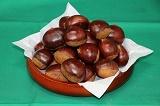Iinuma Kuri
| Registration Number | 38 |
|---|---|
| Name of the GI | Iinuma Kuri |
| Class | Fruit |
| Date of Protection | 2017/06/23 |
| Producing Area |
Ibaraki Prefecture
Ibaraki Town in Higashi-Ibaraki County, Ibaraki Prefecture |
| Applicant - Name and Address | Shimo-Iinuma Chestnut Production and Marketing Association 648-1 Shimo-Iinuma, Ibaraki Town, Higashi-Ibaraki County, Ibaraki Prefecture, 311-3154, Japan |
Unlike ordinary chestnuts, Iinuma Kuri(chestnuts) is large, and has a superior appearance regarding its color, gloss, and shape. This characteristic is due to a cultivation technology that produces one nut per shell, as well as whole nut washing and careful sorting. In addition, long-term cold storage efforts have allowed production of a sweet fruit by increasing the sugar content without deterioration of quality.
In general, chestnuts have three nuts per shell, whereas producers of Iinuma Kuri stick to the production of large nuts with one nut per shell. As a result of repeated studies on pollination, they realized stable production of large nuts (1 ~ 2 nuts per shell) without reduction of yield.
Since all the harvested nuts are washed with a special machine, the bottom part of the nuts is glossy without any stains. Furthermore, by sprinkling the fruits with sawdust and putting all of them in a cold storage, drying, rotting, and quality deterioration are prevented to ship sweet chestnuts with increased sugar content.
For shipment, producers sort the chestnuts twice, before and after storage, and joint selections are made at pick-up points. This triple screening contributes to fewer contamination of defective products. Shipments of Iinuma Kuri amount to about 50 tons each year which is not much compared with other production areas, but due to the high quality and uniformity of the product, it gains trusts from customers. Since they are traded in the market at about twice the price of chestnuts from other regions in the same period, they really are considered to be the highest quality chestnuts.
The production area of Iinuma Kuri, Ibaraki-cho, is a flat plateau with an altitude of about 30 m, and it is covered with weakly acidic volcanic ash soil with good water retention, aeration and drainage. In addition, the region has a stable climate which is an ideal environment for chestnut cultivation; it has an average annual temperature of 13.6℃ and annual rainfall of 1,354 mm.
In the Hitachi Fudoki compiled in the 6th year of Wado (713), it is recorded that good chestnuts were grown since ancient times in the page of Namekata area, the neighborhood of the present Ibaraki-cho.
In Ibaraki-cho, chestnuts were planted in the cultivated land around 1933, and after that, chestnut groves were proactively created from around 1963. Then, with the aim of better profitability by quality improvement of the chestnuts and planned shipments, unions were established mainly by progressive farmers in 1968, and began shipping to the marketplace.


